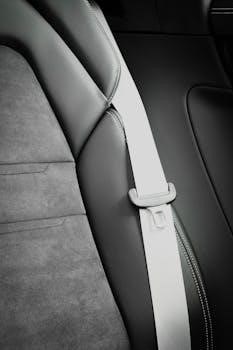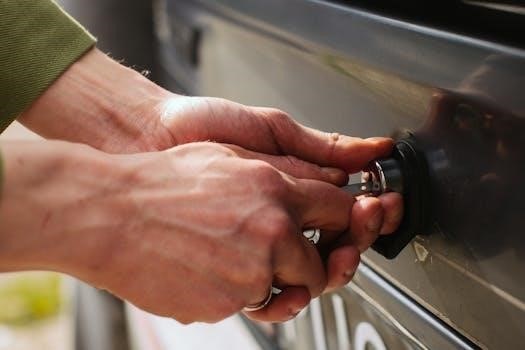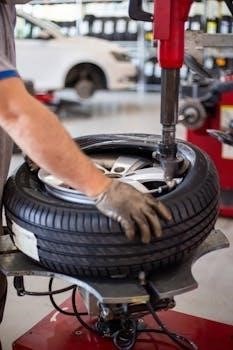Safety 1st Infant Car Seat Manual⁚ A Comprehensive Guide
Safety 1st provides parents with comprehensive guides for their infant car seats․ These manuals are crucial for understanding proper usage, installation, and maintenance․ Accessing and understanding the manual ensures the safety and well-being of your child while traveling․
Understanding the Safety 1st Brand
Safety 1st is a well-known brand dedicated to providing safe and reliable products for infants and children․ They focus on creating car seats that meet rigorous safety standards, ensuring parents feel confident in protecting their little ones․ The brand emphasizes ease of use and practical design, integrating features that simplify installation and adjustments․ Safety 1st aims to make child safety accessible to all families by offering a range of products at different price points․
The brand’s commitment extends to continuous improvement and innovation, regularly updating its car seat designs to incorporate the latest safety technologies and feedback from parents․ By prioritizing safety, convenience, and affordability, Safety 1st has established itself as a trusted name in the industry, helping parents navigate the challenges of child passenger safety with peace of mind․
Key Features of Safety 1st Infant Car Seats
Safety 1st infant car seats are designed with several key features to ensure optimal safety and convenience․ These car seats often include side impact protection, which provides an extra layer of security in the event of a collision․ Adjustable harnesses are another common feature, allowing parents to customize the fit as their child grows, ensuring a snug and secure hold․ Many models also come with removable infant inserts to accommodate smaller babies, providing additional support and comfort․
Furthermore, Safety 1st car seats frequently incorporate LATCH systems for easy and secure installation in vehicles․ The lightweight design of many models makes them easier to carry and transfer between cars․ Parents also appreciate the washable seat pads, which simplify cleaning and maintenance․ Overall, these features work together to offer a safe, comfortable, and user-friendly experience․
Safety Standards and Certifications
Safety 1st infant car seats adhere to stringent safety standards and certifications to ensure the highest level of protection for your child․ These car seats are typically tested to meet or exceed Federal Motor Vehicle Safety Standards (FMVSS) 213, which sets the minimum performance requirements for child restraint systems․ Certification by organizations like the National Highway Traffic Safety Administration (NHTSA) indicates that the car seat has passed rigorous testing for impact performance, structural integrity, and ease of use․

Additionally, Safety 1st car seats often undergo side impact testing to provide enhanced protection in side collisions․ Parents can typically find information about specific certifications and compliance standards on the car seat itself or in the product manual․ Compliance with these standards ensures that the car seat provides a reliable and safe means of transporting infants and young children in vehicles․ Always refer to the manual for detailed information․

Installation Guide
Proper installation is crucial for car seat safety․ This guide provides step-by-step instructions for secure installation using both the LATCH system and vehicle seat belts․ Always refer to your Safety 1st manual for detailed instructions․
Preparing for Installation⁚ Reading the Manual
Before you even think about clicking that car seat into its base or threading a seat belt, the most crucial step is diving headfirst into your Safety 1st infant car seat manual․ This isn’t just a suggestion; it’s the golden rule of child passenger safety․ Think of the manual as your personal Yoda, guiding you through the often-confusing world of car seat installation․
Inside, you’ll find vital information specific to your car seat model․ This includes weight and height limits for your child, proper harness adjustments, and detailed diagrams illustrating correct installation methods․ Ignoring these instructions could lead to improper installation, significantly increasing the risk of injury in a crash․ So, grab a cup of coffee, find a quiet spot, and dedicate some time to understanding the ins and outs of your manual․ It’s an investment in your child’s safety that pays dividends every time you hit the road․
Step-by-Step Installation Using LATCH System
The LATCH (Lower Anchors and Tethers for Children) system is often the preferred method for installing a Safety 1st infant car seat, offering a secure and straightforward setup․ Begin by locating the LATCH anchors in your vehicle’s seat, typically found in the seat bight where the seat back meets the seat cushion․ Consult your vehicle’s manual for their exact location․
Next, attach the car seat’s LATCH connectors to these anchors, ensuring a firm click or secure connection․ Once connected, tighten the LATCH strap to eliminate slack, pushing down firmly on the car seat base as you tighten․ Check for movement; the car seat should not move more than one inch side-to-side or front-to-back․ Finally, if your car seat has a top tether, connect it to the designated anchor point in your vehicle, further stabilizing the seat․ Always refer to your Safety 1st manual for model-specific instructions and diagrams․
Step-by-Step Installation Using Vehicle Seat Belt
Installing a Safety 1st infant car seat using the vehicle’s seat belt is a common and secure method when LATCH is not available or appropriate․ First, carefully thread the vehicle’s seat belt through the designated belt path on the car seat, as indicated in your Safety 1st manual․ Ensure the belt is not twisted․
Next, buckle the seat belt and pull it tight, removing any slack․ Engage the vehicle’s locking mechanism (check your vehicle’s manual for specific instructions on how to lock the seat belt; often, this involves pulling the belt all the way out and then slowly letting it retract)․ Once locked, firmly push down on the car seat base while tightening the seat belt to eliminate movement․ The car seat should not move more than one inch in any direction․ Double-check the belt path to ensure it remains correctly threaded and that the locking mechanism is securely engaged․ Review your Safety 1st manual for specific diagrams and instructions related to your car seat model․
Adjusting Harness and Ensuring Proper Fit
Proper harness adjustment is paramount for your child’s safety in a Safety 1st infant car seat․ Begin by ensuring the harness straps are at or slightly below your baby’s shoulders when the seat is rear-facing․ Refer to your car seat’s manual for specific instructions on adjusting the harness height; this usually involves re-threading the straps through different slots․
Next, tighten the harness so that you cannot pinch any excess webbing at the child’s shoulder․ The chest clip should be positioned at armpit level to keep the harness straps properly located on the child’s shoulders․ Regularly check the harness fit as your child grows, readjusting the straps and headrest height as needed․ A snug harness ensures that your child is securely restrained in the event of a collision․ Always consult your Safety 1st manual for detailed diagrams and instructions specific to your car seat model, as adjustment mechanisms can vary․ Remember, a properly fitted harness is a crucial element of car seat safety․

Usage and Maintenance
Proper usage and regular maintenance of your Safety 1st infant car seat are critical․ Consult the manual for cleaning guidelines and ensure correct harness adjustments․ This will prolong the life of the car seat․
Proper Usage Guidelines for Infants
Ensuring the safety of infants in car seats requires strict adherence to usage guidelines․ Always refer to the Safety 1st infant car seat manual for model-specific instructions․ Before each journey, verify that the harness straps are snug and correctly positioned, typically at or below the infant’s shoulders in rear-facing mode․
Never place a rear-facing car seat in front of an active airbag․ Consult your vehicle’s owner’s manual for suitable seating positions․ The car seat should be installed tightly, minimizing movement․ Routinely check the seat’s recline angle to ensure it’s appropriate for your infant’s age and size, preventing head slump․
Avoid adding aftermarket products not approved by Safety 1st, as they may compromise the car seat’s safety performance․ Regularly inspect the car seat for signs of wear or damage, replacing it if necessary․ Familiarize yourself with the car seat’s expiration date, typically found on a label, and discontinue use after this date․
Cleaning and Maintenance of the Car Seat
Maintaining a clean and well-kept Safety 1st infant car seat is crucial for hygiene and longevity․ Always consult the car seat’s manual for specific cleaning instructions, as methods vary by model․ For the seat cover, spot clean with a mild soap and water solution, avoiding harsh chemicals that could damage the fabric or compromise its fire-retardant properties․
Removable seat covers can often be machine washed on a gentle cycle, but always air dry to prevent shrinkage․ Regularly vacuum the car seat to remove crumbs, dirt, and debris from crevices․ Buckles and harness straps can be wiped clean with a damp cloth; avoid submerging buckles in water, as this can affect their functionality․
Inspect the car seat for any signs of wear and tear, such as frayed straps or cracked plastic, and replace parts as needed, using only Safety 1st approved replacements․ Store the car seat in a cool, dry place when not in use, away from direct sunlight, which can degrade the materials․ By following these guidelines, you ensure your child’s car seat remains safe and comfortable․
Troubleshooting Common Issues
Even with careful installation and usage, some common issues may arise with your Safety 1st infant car seat․ One frequent problem is difficulty tightening the harness․ Ensure the harness straps are not twisted and are properly threaded through the correct slots for your child’s height․ If the harness still feels loose, double-check that the retainer clip is positioned at armpit level․
Another issue can be difficulty with the LATCH connectors․ Make sure the connectors are fully engaged with the vehicle’s LATCH anchors․ If they are difficult to attach or detach, try wiggling the car seat slightly to align the connectors properly․ If using the seat belt installation method, ensure the seat belt is locked and tightened correctly․
Consult your Safety 1st manual for specific troubleshooting steps․ If you encounter persistent difficulties, contact Safety 1st customer support for assistance․ Never use the car seat if you are unsure about its proper installation or functionality․ Addressing these issues promptly ensures your child’s safety․ Remember always refer to the manual first․

Finding and Accessing the Manual
Locating your Safety 1st infant car seat manual is crucial․ Check the Safety 1st website for downloadable PDFs․ You may also find it on websites like Manuals Plus, or contact customer service for assistance․
Where to Find the Manual (Online and Offline)
Accessing the Safety 1st infant car seat manual is crucial for ensuring proper installation and safe usage․ Several avenues are available, both online and offline, to help you locate the specific manual for your car seat model․
Online Resources⁚ The primary source should be the official Safety 1st website․ Navigate to the “Support” or “Customer Service” section, often containing downloadable PDFs of product manuals․ Websites like ManualsPlus also offer user manuals for various Safety 1st car seat models․ Searching for your specific model number followed by “manual PDF” on a search engine can yield results․
Offline Options⁚ If you have retained the original packaging, the manual may be included․ Contact Safety 1st customer service directly via their helpline; they can often mail a physical copy or provide a digital version․ Check with retailers where you purchased the car seat, as they might have access to manuals․